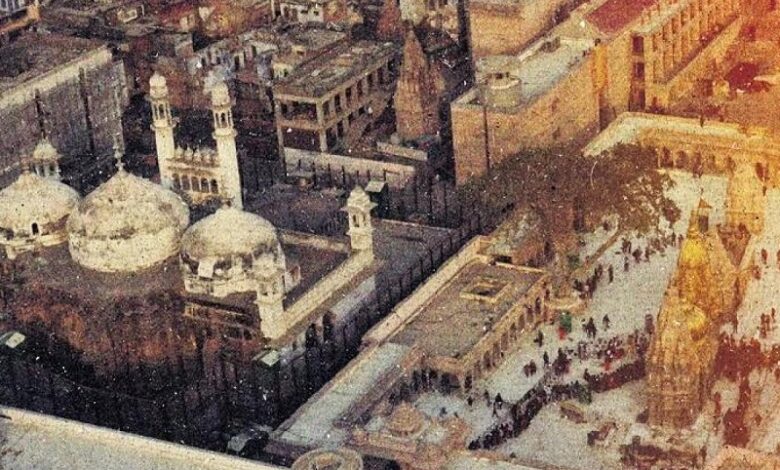
The Gyanvapi Mosque, located in close proximity to the historical Kashi Vishwanath shrine in Varanasi, has found itself at the centre of a prolonged and multifaceted controversy. Beyond being a religious dispute, political undertones echo loudly in the background, as staunch Hindutva advocates assert their positions. This heated discourse is further fuelled by court rulings and assertive petitioners who advocate for a shift in the mosque’s current status quo. Recent developments, including a court-approved survey by the Archaeological Survey of India (ASI), have intensified the controversy, drawing attention to the delicate interplay between religion, politics, and legal interpretations.
On August 3, the Allahabad High Court dismissed a petition aimed at staying an order from the Varanasi District Court. This decision cleared the way for the ASI to conduct a comprehensive survey of the Gyanvapi Mosque. At the heart of the matter is the clash between the Muslim side’s claim that the mosque’s existence for over six centuries renders it untouchable by any suit that might alter its character, and the Hindu side’s assertion that their plea for year-round worship of Hindu deities within the mosque premises is consistent with the Places of Worship (Special Provisions) Act of 1991.
The core issue emerges from differing interpretations of the Act’s provisions. The Muslim perspective maintains that any alterations to a place of worship existing prior to August 15, 1947, go against the Act’s spirit. In contrast, the Hindu viewpoint, rooted in the notion of regular prayers offered within the mosque until 1993, suggests that their suit aligns with the Act’s stipulations.
The controversy surrounding Gyanvapi has evolved over time, with various demands emerging incrementally. Beginning with a group of petitioners seeking the right to worship Hindu deities within the mosque, the controversy escalated to encompass more comprehensive issues such as restraining non-Hindus from the premises. Court orders have subsequently directed the ASI to investigate whether the mosque was built over a pre-existing Hindu temple structure, a step that many fear could challenge the established status quo.
The evolving legal battle reveals nuanced arguments from both sides. The Varanasi court’s dismissal of the contention by the mosque’s caretakers, the Anjuman Intezamia Masjid Committee, suggests that the Hindu petitioners merely seek the right to worship within the mosque, without transforming it into a temple. Moreover, the court emphasizes that if regular worship did continue beyond 1947, it doesn’t contradict the Act.
Despite the legal complexities, concerns abound regarding the potential implications of a court-mandated investigation into the mosque’s history. The Places of Worship Act explicitly safeguards the religious character of places of worship as they existed on August 15, 1947. As such, discovering historical evidence suggesting the presence of a Hindu temple beneath the mosque could prove inconsequential, as the Act operates as the guiding principle.
Critics have raised questions about the motives behind the ASI survey and its potential to undermine the Places of Worship Act. The survey’s objective is to establish historical truth rather than strengthen the religious status quo. Such endeavours could inadvertently contribute to a specific narrative that undermines communal harmony and disregards the constitutional values enshrined in the Act.
The Gyanvapi Mosque controversy evokes concerns about the broader implications of historical re-examinations. Echoing this sentiment, Samajwadi Party MP Swami Prasad Maurya highlights the need to respect the status quo of religious places as of August 15, 1947, to prevent unnecessary disputes. This approach, he contends, will avoid a slippery slope of seeking ancient relics within religious structures, which could further fuel tensions and conflicts.
The Places of Worship Act, enacted in 1991, aimed to heal historical injustices by preserving the character of religious sites as they existed on August 15, 1947. The Act’s intent was to uphold India’s commitment to religious equality and secularism. However, the ongoing Gyanvapi Mosque controversy has raised questions about the consistent application of this Act in the face of evolving demands and political pressures.
The situation reflects the complexities inherent in balancing historical truths, religious sentiments, and constitutional values. Despite attempts by some to find remnants of other faiths’ structures within religious sites, such endeavours often perpetuate divisive narratives rather than fostering unity. Critics argue that these actions hinder the pursuit of constitutional morality and the promise of equality among all faiths.
The Gyanvapi Mosque controversy serves as a microcosm of the intricate interplay between religion, politics, and law in India. The clash of interpretations surrounding the Places of Worship Act reveals the challenge of maintaining historical accuracy while upholding constitutional principles. While historical investigations have their place, they must not undermine the spirit of legislation aimed at preserving religious harmony and ensuring that history’s wrongs are not wielded as instruments to oppress the present and future. The judicial process’s role in upholding the constitutional promise of equality among all faiths remains paramount, underscoring the importance of carefully navigating this nexus of complex issues for the nation’s continued harmony and progress.
News Mania Desk / Agnibeena Ghosh 26th August 2023






